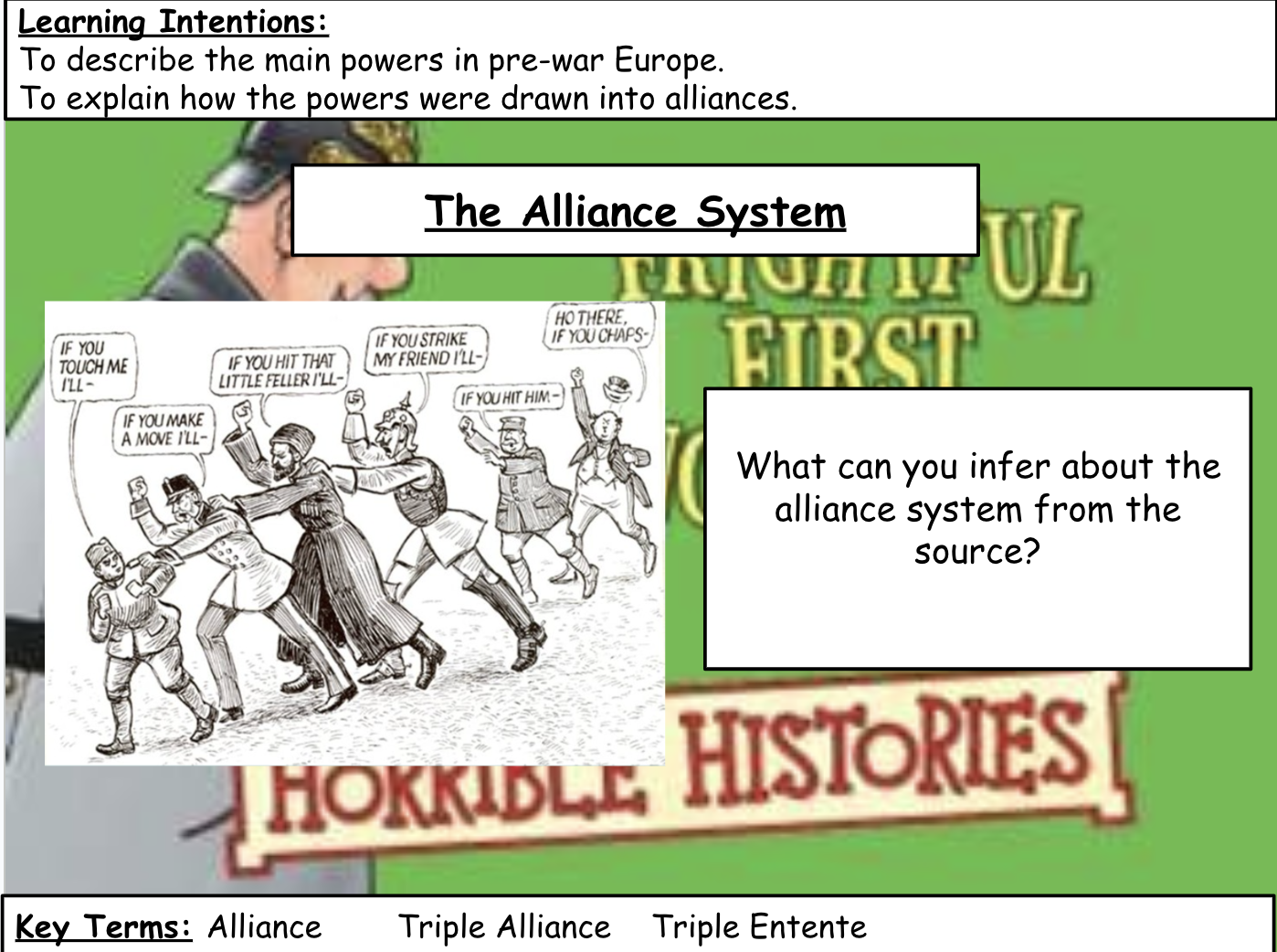8 May - 14 May
Section outline
-
EXPLORE / TŪHURA learning intentions:
- We are EXPLORING to know there are different types of sources available to interpret historical events
- We are EXPLORING to understand that different types of sources have different strengths and weaknesses.
- We are EXPLORING to be able to weigh up the strengths and weaknesses of sources and decide how reliable a source is
Germany
Before 1870 Germany was a collection of small independent states including Prussia, the most powerful. In 1870 it had won a war against France and wanted to ensure that it had help from neighbouring countries in case of a future attack from France.
By the 1890s they had become aggressive under Kaiser Wilhelm II.
The Kaiser wanted to build up its overseas colonies like France and Britain had.
Kaiser ordered the building of a large Navy which was only second to Britain.
German leaders were worried about the country being encircled by enemies.
Germany feared the build up of arms by countries such as Russia in the East.
Learning Intentions:
To describe the main powers in pre-war Europe.
To explain how the powers were drawn into alliances.The Triple Entente (French for agreement): this was between Britain, Russia and France.
- The Triple Alliance: This was between Germany, Italy and Austria Hungary.
The Alliance System
By 1914 the most powerful countries in Europe were divided into two opposing Alliances.
In your groups you have been given an information card for the main countries that were involved in World War One. Each of them were part of an alliance with countries that shared their ideas and could be counted as allies.
Task
You must decide what countries should form an alliance based on the information on the cards.
You will have to justify you answer.
Germany
Before 1870 Germany was a collection of small independent states including Prussia, the most powerful. In 1870 it had won a war against France and wanted to ensure that it had help from neighbouring countries in case of a future attack from France.
By the 1890s they had become aggressive under Kaiser Wilhelm II.
The Kaiser wanted to build up its overseas colonies like France and Britain had.
Kaiser ordered the building of a large Navy which was only second to Britain.
German leaders were worried about the country being encircled by enemies.
Germany feared the build up of arms by countries such as Russia in the East.
Austria-Hungary
Austria-Hungary was a sprawling empire in central Europe. It was made up of people of different ethnic groups: Germans, Czechs, Slovaks, Serbs and many others. Each group had its own customs and language. Many of these groups wanted independence from Austria-Hungary.
By 1914 the main concern for the Emperor of Austria-Hungary was how to keep the empire together.
The Serbs living in the south wanted to be joined to the neighbouring state of Serbia.
Serbia was becoming a powerful force in the Balkans and Austria-Hungary did not want it to become even stronger.
Another neighbour Russia supported the Serbs and had a very strong army.
Italy
Like Germany, Italy was formed from a collection of smaller states. At first, its main concern was to get its government established, but by 1914 the country was settled and looking to ‘flex its muscles’.
Just as Germany had Italy wanted to set up colonies and build up an overseas empire. It therefore looked for allies that shared similar interests.
Italy wasn’t a strong industrial of military power and there for looked for powerful allies.
Britain
Britain had tried to avoid European politics by adopting a n isolation policy from the rest of Europe.
By 1900s this had changed.
France and Britain and reached a number of agreements about colonies in North Africa.
Russia had been seen as a threat but their loss to Japan in 1904 meant that they were no longer seen as a threat.
Britain's industrial output had been overtaken by Germany in this period and they now seemed to be the biggest threat to Britain and its neighbours.
France
France had been defeated by Germany in 1870. Since then, Germany had built up its army and industry under the ambitious leadership of Kaiser Wilhelm II. France responded by also building up their military and industries.
France also developed a strong relationship with Russia in response to the fear from the central European powers.
France had two great aims:
To protect itself from attack
To regain the rich industrial region of Alsace-Lorraine which had been taken from them by Germany in 1870.
Russia
Russia was by far the largest of the six powers but it was also the least advanced. It depended on agriculture predominantly and any industry had relied on loans from France.
It shared the worries France had about Germany as well as having a long standing rivalry with Austria-Hungary which led to their friendly relationship with Serbia as they were both Slav nations and believed that they should have influence over the other Slavs in Austria-Hungary.
1905 Russia lost a war to Japan and the ruler Tsar Nicolas II knew that he could not afford to lose another conflict and therefore built up their army in case of future conflict.

Task
How might the alliance system lead to large scale conflict in Europe?
Success criteria:
Make a judgement on how it could lead to conflict.
Give a reason for your judgement.
Use the source as evidence to support your answer.
Finished? How useful is this source in telling us about the alliances?
“The first world war broke out because of Germany’s acquisition of overseas colonies and the development of a large navy.”
What evidence do we have that this statement is accurate?
What evidence do we have that it isn’t?
